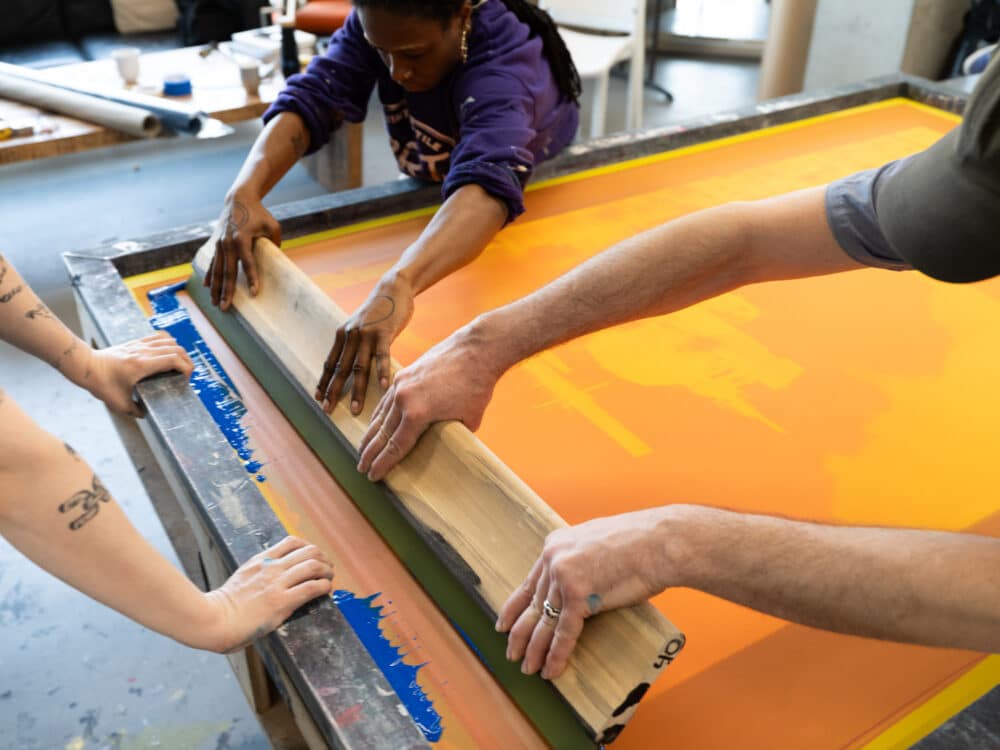ChatGPT said: 10:9 Design Embroidery success stories: how clients upgraded their brand identity
The Important Guide to Recognizing Screen Printing and Its Versatile Utilizes
Screen printing has a rich background that goes back to ancient times, evolving right into a sophisticated strategy utilized across different markets today. This overview explores the ins and outs of the screen printing process, describing its applications in advertising and marketing, home, and style design - 10:9 Design Company. Recognizing these fundamentals can open up imaginative potential for both industrial and creative jobs. The complying with areas will expose important pointers and methods to improve one's screen printing endeavors
The Background of Screen Printing
Screen printing has origins that trace back centuries, its evolution shows the artistic and technical improvements of different cultures. Coming from ancient China, the method was at first made use of for embellishing fabrics and later infect Japan, where it became integral to Ukiyo-e woodblock printing. The technique shifted to Europe in the 18th century, where it gained appeal among craftsmens and commercial printers. The development of photo solution in the 20th century reinvented screen printing, permitting for more detailed styles and higher effectiveness. Artists like Andy Warhol additionally propelled its appeal, making use of the tool to create iconic jobs that blended commercialism and fine art. By the late 20th century, screen printing had developed itself as a functional strategy, used in vogue, advertising and marketing, and great art. Today, it remains to advance, integrating electronic modern technology and broadening its applications throughout numerous sectors.
The Screen Printing Refine Explained
Screen printing changes imaginative visions right into tangible layouts through a collection of accurate steps. A picture is created and then transferred onto a screen, generally made of great mesh textile extended over a frame. A light-sensitive emulsion is put on the screen, which is exposed to light, solidifying in areas not covered by the image. After rinsing the unhardened emulsion, a stencil is created.
Next off, the screen is placed over the substratum, whether it be material, paper, or another material. Ink is then pushed with the open areas of the pattern using a squeegee, transferring the layout onto the substrate below. This procedure can be repeated for multiple shades, needing different screens for every color. Lastly, the printed thing is cured making use of heat to ensure the ink sticks appropriately, causing a durable, lively design on-line.
Types of Screen Printing Techniques

Additionally, specialty techniques, such as discharge screen printing, remove color from the fabric to create softer prints, while aluminum foil screen printing uses metallic aluminum foil to accomplish a glossy surface (10:9 Design reviews). Each strategy uses distinctive qualities, satisfying different innovative requirements and manufacturing ranges, inevitably broadening the possibilities within the screen printing domain
Applications of Screen Printing in Numerous Industries

Furthermore, the signs and marketing fields use screen printing for creating captivating displays and banners. This approach permits for vibrant shades and elaborate layouts that record focus. In electronic devices, screen printing is used for applying conductive inks to circuit card, important for component links. Additionally, the home décor market accepts screen printing to create distinct designs on fabrics and wall art. In general, screen printing works as a vital tool throughout varied fields, boosting products with personalized and visually appealing graphics.
Tips for Effective Screen Printing Projects
While undertaking a screen printing job, careful focus to detail can significantly enhance the last outcome. Selecting top notch materials is necessary; this includes the screen, inks, and substratums. Using suitable mesh matters can impact ink deposition and information resolution. Prep work is equally vital; comprehensive cleansing of displays and appropriate exposure times ensure crisp prints.
Next off, accurate enrollment is important for multi-color prints. Utilizing positioning tools can help accomplish exact layering. Furthermore, screening prints on scrap products prior to production aids recognize potential issues without squandering sources.

Frequently Asked Inquiries
What Materials Are Best for Screen Printing on Fabric?
Cotton and polyester blends are suitable for screen printing on textile because of their durability and ink absorption. In addition, specialty fabrics like silk or canvas can produce special textures and coatings, enhancing the total layout top quality.
How Do I Tidy and Maintain Screen Printing Equipment?
To preserve and clean screen printing equipment, one must regularly wash displays with ideal solvents, examine squeegees for wear, oil relocating components, and shop all products in a dry, dust-free environment to prolong their life expectancy.
What Are the Ecological Influences of Screen Printing?
Screen printing can have significant ecological effects, consisting of chemical waste from solvents and inks, water use throughout cleansing procedures, and energy usage. Environmentally friendly products and lasting methods are essential for reducing these negative effects.
Can Screen Printing Be Done at Home Properly?
Screen printing can be effectively done at home with the right products and methods. Enthusiasts can create high quality prints, though success depends upon their skill degree, tools, and understanding of the process included.
What Are the Prices Linked With Beginning a Screen Printing Business?

Beginning a screen printing organization includes prices for equipment, materials, and workspace. Preliminary costs normally vary from a few hundred to numerous thousand bucks, depending on the range, top quality of equipment, and website wanted manufacturing capability.
Screen printing has a rich history that dates back to ancient times, developing right into an advanced method used throughout numerous markets today. An additional strategy, rotary screen printing, utilizes cylindrical screens, promoting continuous printing on textile rolls, thereby enhancing effectiveness for large-scale productions. In addition, specialized strategies, such as discharge screen printing, get rid of dye from the fabric to produce softer prints, while foil screen printing uses metal foil to attain a glossy coating. In the fashion industry, screen printing is commonly made use of to create lively styles on garments, enabling brands to showcase their distinct styles. Cotton and polyester blends are suitable for screen printing on fabric due to their longevity and ink absorption.